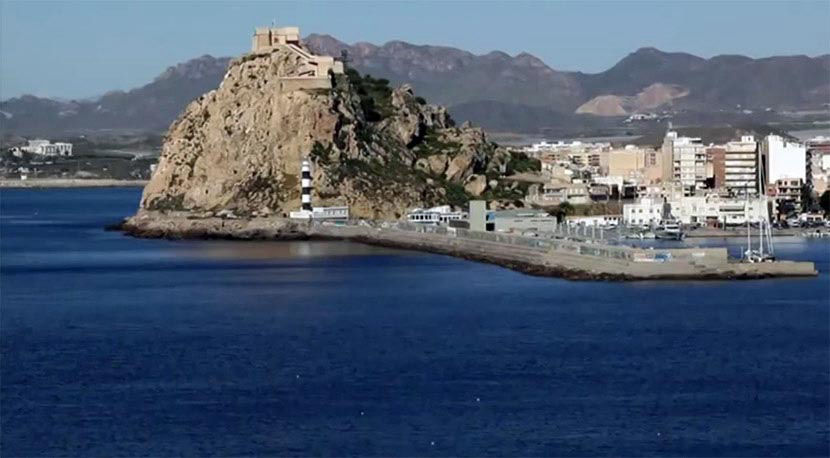
INTRODUCTION

From the hill of the castle, we can enjoy with the audioguide impressive views of Aguilas and the surrounding countryside. The city is located on the southeast coast of the Region of Murcia, bordering Andalusia. This territory, due to the differences in terrain, , is isolated. For this reason, commercial activity has been historically made by sea. The history of the city is closely linked to the castle´s history. The population re-grew when the fortification was enabled, in the mid 18th century. The castle has recently been fully restored. It can be visited as an attraction in itself, or can form part of a morning out, visiting various sites in the town. It is one of the best places of cultural interest of the city.
The castle of Saint John stands on the top of a mountain where, long ago, a Hisn, a Mussulmen fortress, was located. In the 16th century, a tower with a hexagonal ground plan was erected in this place in order to protect the territory. However, this region faced long periods of abandonment due to its proximity to Granada. This city was reconquered, and later suffered the corsair threat after Granada was taken in 1492. After construction of the Tower of Saint John, the intentions of repopulating the area were unsuccessful, due to the intense pirate activity.
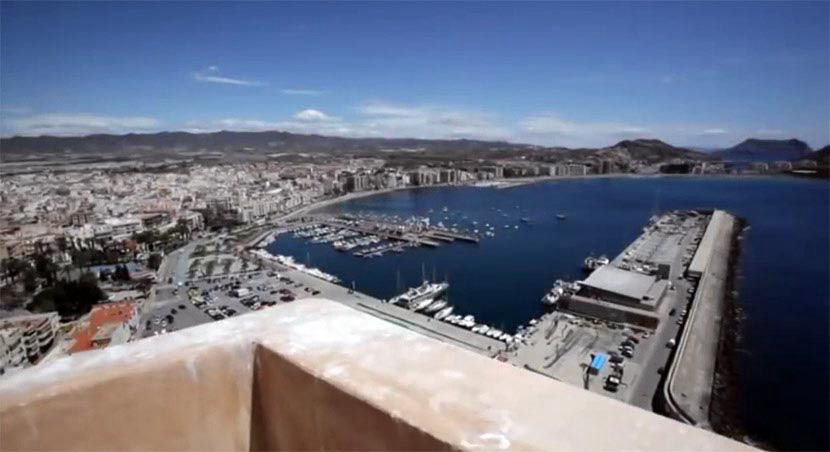
The current castle you can see with the audioguide was completed in 1756, in the reign of Ferdinand the VI. The engineer, Sebastian Feringán, designed the castle in such a way as to avoid the constant attack from Berber and Turkish pirates, who ravaged the coastline at that time. The castle is comprised pf three distinct structures: The Saint John fort, the Saint Peter cannon battery, and the fortress that joins these structures. Saint John fort is located to the West. It has a central courtyard and a terrace for the artillery. On the first floor, we find rooms arranged for lodging, a kitchen, and a basement that housed storage, a magazine and a dungeon. Communication between the three floors is by way of a spiral staircase.
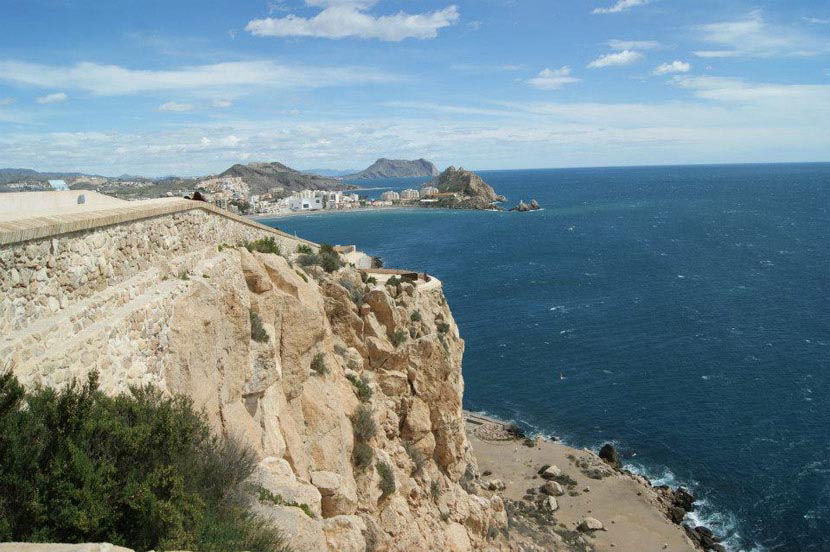
The Saint Peter cannon battery faces towards the East. It has a semicircular floor. There are a number of buidings that come up against the north side. The rest of the square consists of the Barberett battery, which defended the port. The 3rd structure connectsi Saint John Fort and the Saint Peter cannon battery. This fortress was built with a side bench for the infantry and two little forts, San Jose and San Felipe, that defended access to the castle by land.
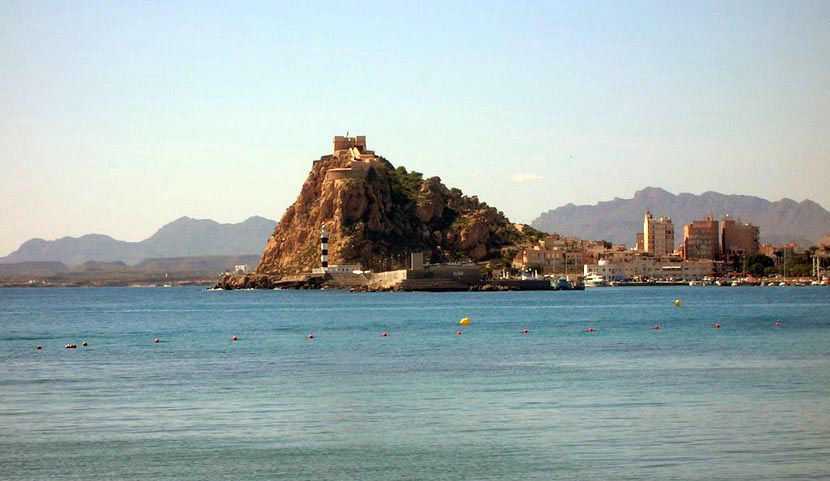
At that time, the first municipal project was created. Feringán signed it in 1757. The project consisted of a military type settlement with a pentagonal shape, defended by a bastioned wall. However, the project never was carried out. The second and final project was started by Vodopich in 1765 after receiving, in the same year, a visit of the Count of Aranda. At that moment he was the General captain of Valencia and Murcia. Today, the settlement is in the form of a grid, and is commanded at a central location, a regular pattern used in modern times.
The reconstruction of the entire building has made it possible to make this the home of the Aguilas Historical Learning Center, whose audioguide is also available. Therefore, we will try to explain the building from two different aspects; on one hand we will show you the building itself, detailing the uses of its rooms. On the other hand, you will see the castle´s contents and thematic areas. It allows us to become familiar with the territory and understand the evolution of the town of Aguilas.
ENTRY
The entrance to the fort is located on the west side, near the fort of Saint John. The coat of arms of King Ferdinand the Sixth, who ordered the construction of the fort, is placed at a certain height in the north façade. Below the coat of arms, an inscription in marble was placed. The original has disappeared, but it read in latin: "Built by the order of Ferdinand the Sixth in the year of our Lord 1756".
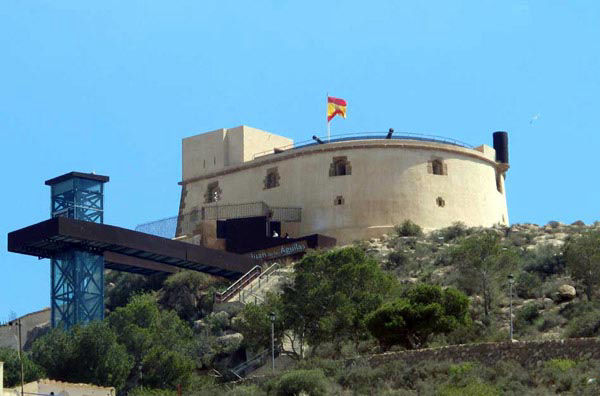
THE PARADE SQUARE
We go forwards now with the audioguide to find ourselves in a large square, the Parade Square. In front of us, we find a building standing by itself. Initially, this was the old guardhouse of the fort, but now it is used as the Reception Center. Only lower floors of the building have been rebuilt, using modern architectural patterns. To the right of the square, we can appreciate a beautiful view of the coast of Levante, Aguilas´ landscape and the sea. A small sandstone block platform can be seen along with the wall that encloses the square from the south. It was the site of a piece of artillery that defended the castle.
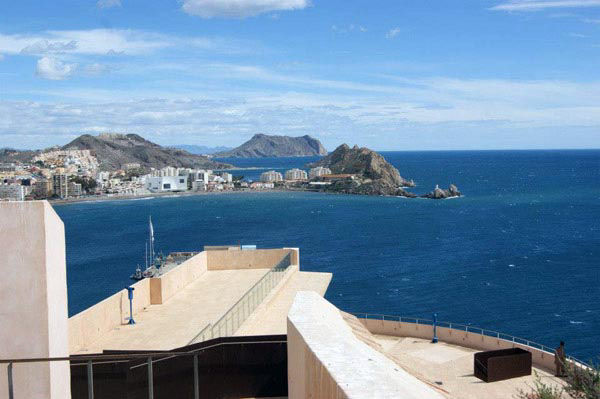
We re in front of the main ’façade', and observing the layout of the fort. On the top, we see a series of small loopholes, and a cantilevered work over the door. It is called matacán. From these points, the fort was defended. The door is positioned at a certain height, and is accessed by way of a drawbridge resting on a ladder.
MAIN FLOOR
Entering the main floor of the Fort with the audioguide, we find a central courtyard with a water well in the center. It collects the rainwater coming from the roof. The water runs through three cylindrical gargoyles and a series of rooms that are set around the well. The function of these units went through a number of changes since the castles construction. Nevertheless, this floor was primarily used as a lodgement area for the troops. In 1848, for example, we have a reference regarding the distribution of units of this main floor.
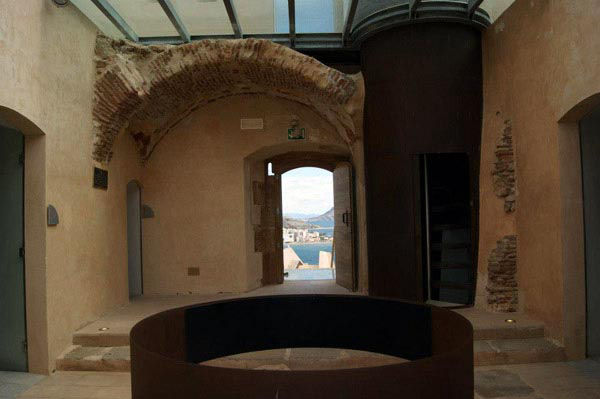
From right to left, coming from the entryway, we have: the officer´s room, the sergeant´s room, three units for troop headquarters, connected to each other, the kitchen, and two other units designated for the barracks. From one of them, we can access, by a staircase, the dungeons located on the lower floor. They occupy two rooms, separated from the rest of the basement. Now, we begin the tour of various rooms containing museum artifacts.
ROOM No.1
Next section of this audioguide, Room 1, to the right, is dedicated to the topography of the area. Aguilas is located on he Mediterranean coast of the Iberian Peninsula, at the eastern end of the Betic Mountain rage. This geographic situation is a main influence on the landscape and climate, characterized by low rainfall, as well as the moderate temperatures caused by the proximity of the sea. In addition, this territory, due to its varied relief, is isolated. For this reason, its commercial activity has been historically made by sea.
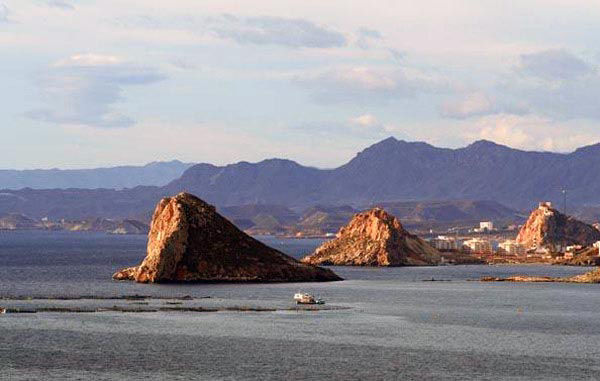
ROOM No. 2
Room 2 that you can visit with the audioguide is dedicated to Geology, to the formation of the land and the study of minerals and mining. The rocks of Aguilas tell us a story that is older than man`s memory. It is a complex history that begins at a moment in the Paleozoic Era, more than 250 million years ago. This era was the beginning of the formation of the surrounding terrain, which has a high geomorphological complexity and a wide lithological range. Some of these materials are of economic interest, and have been exploited since antiquity. Mining reached a great importance in the late 19th century and early 20th century, thanks to the exploitation of iron, lead and silver from the nearby mountains. A number of monuments in the city remind us of this. For example, the pier of minerals called The Hornillo, the monument to the railway, and some of the downtown buildings.
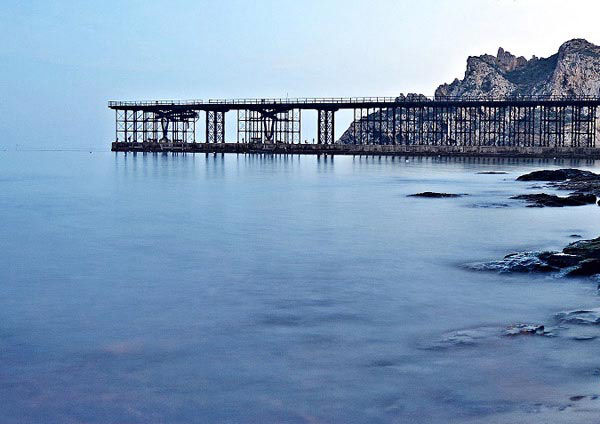
Room No.3 and No.4
Rooms and 4, connect to each other, and describe both the coastal and interior areas. In room No.3, the landscape of the interior and its values are defined. There is a natural mosaic in the mountains of Aguilas, the contrasts between mountains, valleys, torrents, crops, forest areas, cottages, and so on. Landscapes such as the Sierra Almenara (the most interior of the arcs of mountains ), cape Cope (the most representative example of the shoreline) or The Mayorales and Peña Rubia (the intermediate reliefs between Almenara and the coast) highlighted in this beautiful scenery.
The mountains provide water and nutrients to the rest of the land through a complex hydrographic network. The wadis riverbeds that only carry water in times of heavy rain are the most relevant element in this network . They are the nexus between all of the aquiline landscapes. Before flowing into the sea, the wadis cross valleys and coastal plains. The flowing process of the water has deposited sedimentary materials over millions of years. This is the main reason why these areas have traditionally been used for agriculture.
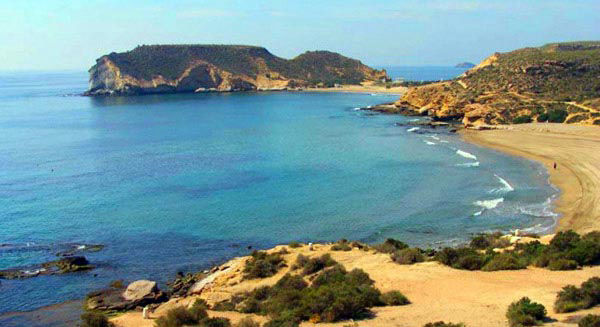
In room No.4, the coast is described. The sandy beaches, alternating with promontories and coves, some of them with rocks, are some of the most notable characteristics of the sea landscape of Aguilas. Every corner of the municipality is different and has its peculiarities regarding the landscape. There is a wide variety of plant species described in this audioguide: the characteristic scrub-covered area of the mountains; the vegetation that grows in the river beds a principal characteristic is the adaptability to the periodic destruction caused by the floods; the are greenhouse crops that occupy a large area of coastal plains; plants adapted to the harsh conditions of the coast, many of them classified as endemic, rare or vulnerable; the seagrass beds of Posidonia that grow deep in the ocean, etc. The fauna harboring the municipality is very interesting: mammals, reptiles, invertebrates, birds, marine species, etc.
ROOM No. 5
In Room No.5 we will learn with the audioguide about a new theme the History of Aguilas. In this room, the city's history is explained, from prehistory to the construction of the Castle. The first settlements of Aguilas date from the Neolithic period. These occupations subsequently continued in the Chalcolithic period and in the Bronze age. Later there were Iberian, Romanic and Medieval Era settlements. The Historiography has raised multiple theories about the name of the Roman settlement underlying the current town. Some authors identify it as Urci city. After the Reconquest, control over the Kingdom of Murcia was transferred to the border area between the Kingdom of Aragón, the Nasrid kingdom of Granada and the Mediterranean. The area was largely unpopulated until the 18th century due to the constant incursions, first from the Moors across the border from Granada, and later due to the threat of pirate and Berber invasions by sea. To defend the coastal area, the Tower of Cope and the Tower of Saint John were built in the 16th century. The latter was placed on top of the hill, where the 18th-century castle stands.
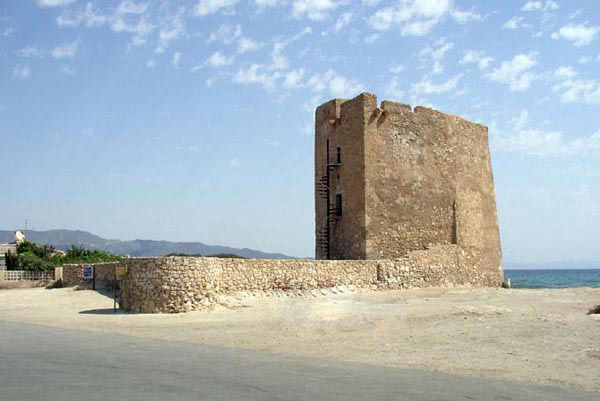
ROOM No.6
Room No.6 is the kitchen of the castle. It has been re-created with the same environs of the 18th century kitchen. We can clearly observe its original make-up the fireplace, hearth, cupboard, etc. We can also observe with the audioguide the furniture and other objects: jar, booklet, pan, glasses, table, copper, etc. There are also objects relating to eating, and products and a number of objects from the ranch.
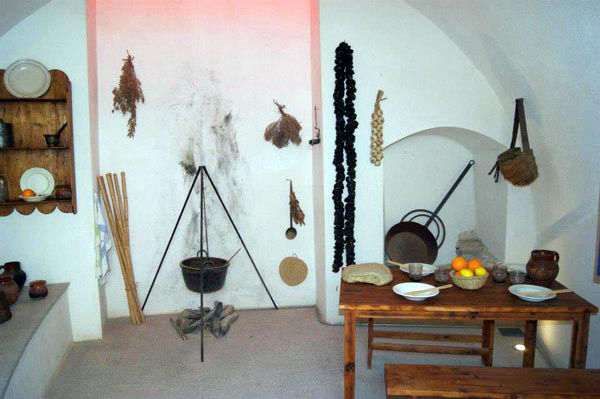
ROOM No.7
We now reach room No. 7 with the audioguide. It not only describes the history of the construction of the Castle, but also places us in that moment. You will learn of the people related to the construction of the fortification. Due to the prevailing insecurity in the area on account of the Berber and pirate threat, a defensive tower was built in 1579. Saint John the Baptist was entrusted to the tower defence. The current castle was built in the same place as the original-one and none of the original remains. The tower was continuously assaulted until it was destroyed. The Duque of Caylus, the Captain General of Valencia and Murcia, ordered the project of rebuilding the Castle. This responsibility was carried out by Feringán in 1752, although the fortification was not completed until 1756.
ROOM No.8
At last, room No. 8 displays the moment when people of influence decided to found the new town of Aguilas. The history of the city of Aguilas is closely linked to the Castle of Saint John. Under the protection of the new fortress, important commercial activity flourished. It helped the town come back to life. In 1765, the project launched by the Count of Aranda in order to repopulate Aguilas was approved by Royal Decree. The plan was part of a general policy promoted by the Bourbon monarchy. The new city center experienced a fast growth that helped it to achieve independence from the City of Lorca in 1834.
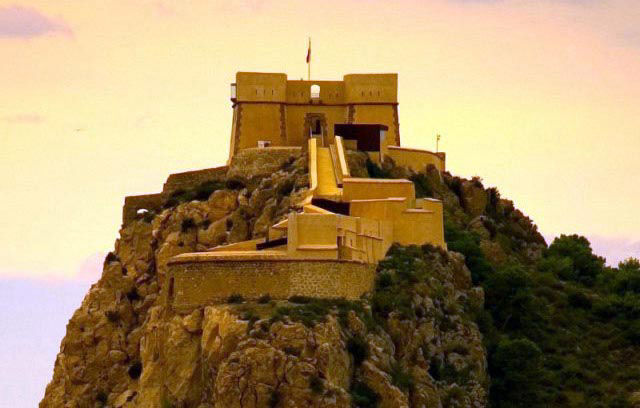
DUNGEONS
Following the audioguide, in the next room, we will see a little space, which will lead us through a narrow hallway and stairs until we reach two separate rooms in the basement. These were used as dungeons starting in the 19th century. As with the kitchen, the original arrangement of these rooms have been recreated. When a soldier committed an offense determined as severe, he was punished, meaning he had to sleep in these dungeons. One reason for such punishment was a soldier returning drunk. Many civilians were also imprisoned in these units. Sometimes they came to be filled, as in the 1st half of the 19th century, during the Carlist Wars. Since it was a dark and mysterious place, the setting uses the sound, lighting and staging effects to carry us to the same environment of that time.
WAREHOUSES
We go out again with the audioguide to the courtyard. To the right, we find the spiral staircase connecting th main floor to the basement and the terrace. We head to the lower level. All the basement areas, except for the two rooms used as dungeons that we have already visited, were meant to be used as areas for food storage. However, one of the rooms was used to store gunpowder. The two rooms intended for dungeons could be accessed independent of the others.
ROOMS No.11 and No. 12
We go towards the two rooms located on the left (rooms 11 and 12) with the audioguide. In these rooms, the development of the city since its foundation is explained, along with the economic sector that allowed such development. The little village once inhabited by laborers, farm workers and fishermen, after obtaining independence from Lorca, became an important commercial center. Products were exported nationally and internationally.
Since the 17th century, the tuna fishery industry based in Cope and Calabardina, together with the wheat and barilla industries, were the major source of income for the region. Nevertheless, mining in the mid-19th century, and, later, the esparto business, became the main engines of economic development in Aguilas. This development gradually transformed the appearance of the village.
From the urban point of view, there are important buildings in Aguilas. They highlight the city’s urban growth. The three great works that placed Aguilas at the top regional level are: the Port, the Railway and the pier of minerals called The Hornillo. The city’s growth is reflected in these dates. In 1833 (the year before independence from Lorca), the city had 1,348 habitants, and in 1910, the population reached 15,403 citizens.
NORTH WING
Once we have visited these two rooms, we continue with the audioguide down the hall to the north wing, where we find Rooms 13, 14, 15 and 16). They were also used storage, but the room 13, was also used for a magazine and has been remodeled this way. This area shows the construction of the fort, and the materials used in its construction: masonry, lime mortar and brick.
In these four rooms located in the north wing of the basement, you will learn about the daily life of the soldiers. The fort was commanded by the Governor, who was accompanied by other officers of lower rank. Upon the completion of the castile, the first garrison, consisted of twenty five men from the Provincial Militias of Baza. Prior to that, they were in charge of the protection of the castle while it was under construction.
The soldiers did not always enjoy good living conditions, nor a decent salary. Delays in paying forced them to go as far as leaving heir posts in order to search for other employment, such as harvesting. Also, given the isolation of the Fort, the detachment members had to leave the square to fulfill religious duties or to receive medical care, since they did not have these services in the Castle.
SQUARE FOR THE ARTILLERY
We go back to the stairway with the audioguide in order to ascend it and reach the terrace. On this top floor, the parade ground for artillery was placed. Platforms or artillery seats for the guns, arranged radially, can be observed. Two of these original pieces, provided by the Navy, are on their gun carriages in these seats. In front of the staircase, the guardhouse has been reconstructed. A room intended for tower keepers on guard (room No. 20) and another one for the watchman of the sea (room No.19), were located in the eastern part of the front. They were separated by the matacán, defending the door.
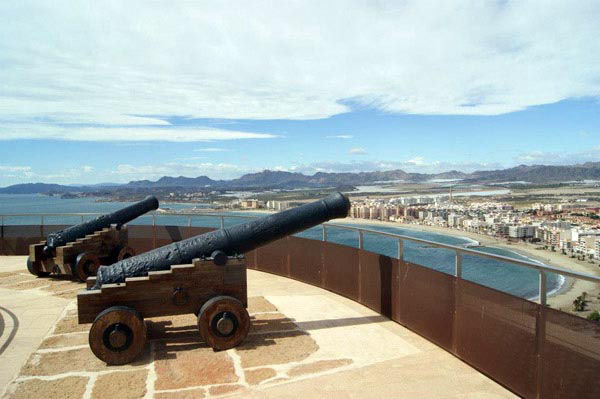
In this section, the defense system used in the Fortification is explained, showing pieces of real artillery on top of gun carriages. There are alsopanels that explain the defensive systems: the barbette battery and the artillery system with open embrasures on the parapet. The latter system is preserved in the forts of San Jose and San Felipe, in connection to communication with the Battery of Saint Peter.
ROOM OF THE WATCHMAN
Next to the stairs, in the room of the watchman (room 19) the defenses in the Mediterranean sea are explained in this section of this audioguide. There were other means of defense, before the use of gunpowder and cannons. However, the towers and walls of a certain height secured the control of the ports. It was possible because they had perfect control over the surrounding area. The widespread prevalence of modern artillery, around the 15th and 16th centuries, started a revolution in the art of fortification. The main ports were defended with bastioned walls. These walls, having a lower height and greater thickness, could better resist the impact of enemy artillery. At the same time, the wide esplanades of these city walls facilitated the installation and management of the guns. River mouths and coasts began to be dotted with towers and batteries. They defended and controlled the main anchorages, thanks to their wonderful artillery. We have examples of them in the ports of Cartagena (Spain), Cádiz, The Ferrol, Orán, Ceuta, Cartagena de Indias, Veracruz, Habana, etc.
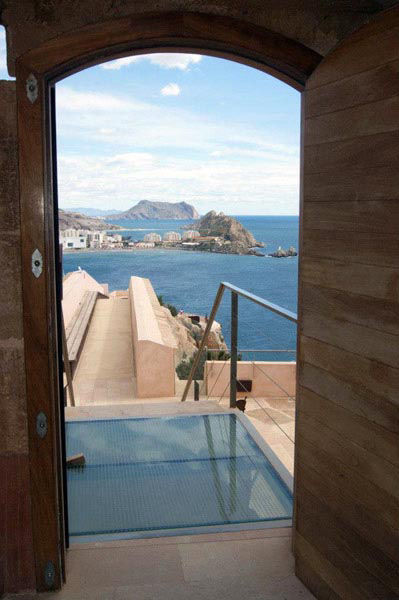
A certain level of constructive evolution was also reflected in the Castle of Saint John. A plan from 1785, almost two decades after the castle´s construction, demonstrates these progressive steps . The most significant example of this is the change performed in the defense system, when the embrasures were replaced by a barbette battery system.
TOWER KEEPERS ROOM
On the opposite side, the room of the tower keepers (room 20) is intended to show defenses on the coast of Murcia. The Castle of Aguilas is immersed in a defense network of particular importance for that time: the entire coast of the region was fortified to stop all kinds of enemy incursions, strategic and piratical. Safeguarding the border required a great material, human and economic effort. Now we leave the Fort with the audioguide and head to the Square of Arms, our starting point.
THE LANDSCAPE RUNWAY
After visiting the fort of Saint John with the audioguide, we head to the other end of the Fortification: the Battery of Saint Peter. It is located at the east and its main function is to defend the harbor. The path to the battery is through a long corridor: the Communication. This transit area has been called "The Landscape Runway", since, from this point, visitors can interpret and understand the surrounding landscape elements: Fraile Island, cape Cope, Lomo de Bass, cape Peña Rubia in the region of Murcia and El Aguilón, Sierra of Cabrera, Island of Terreros or Mesa de Roldán in Andalusia.
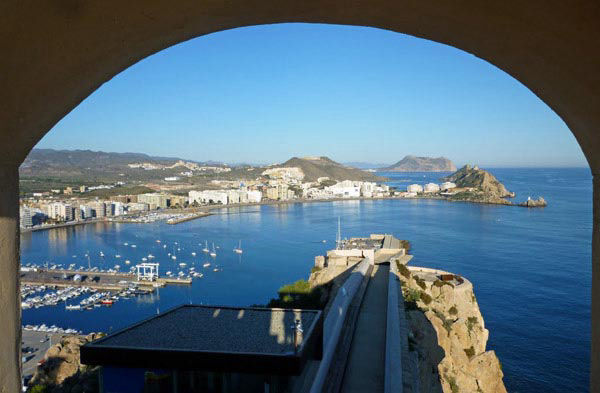
This gateway, as we have mentioned, joins the two main sections of the defensive complex: Saint John Fort in the west and Saint Peter battery in the east. The bank that stretches to the north wall of this long corridor, was used as a bench for the infantry, in order to defend possible assaults by land.
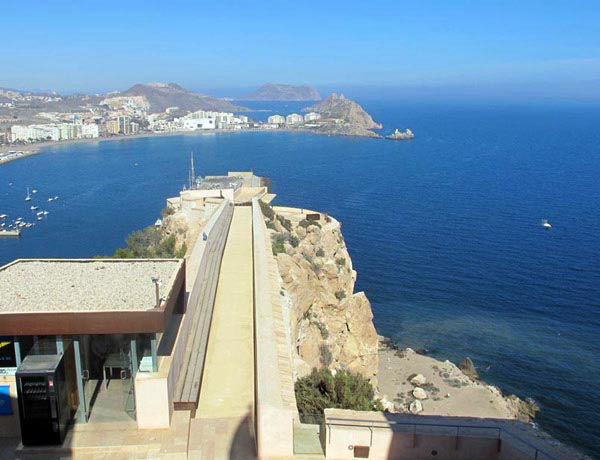
FORTS
As we get closer to the battery, we can see with the audioguide, at the east end of this runway, the forts of San Jose and San Felipe. They housed two artillery pieces that used to display their mouths through impressive embrasures. These loopholes defended the blind spots in the two main centers of defense.
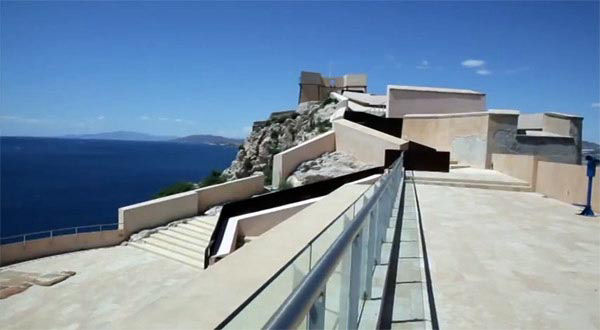
BATTERY OF SAN PEDRO
We continue down the stairs with the audioguide and arrive at Saint Peter battery. This battery will be used to explain the evolution of the design of its structure, and its usability as well. According to the original plan, the Fort of Saint John was joined by a runway with Saint Peter battery. The battery featured a triangular esplanade. The part facing the west side was in the form on an arch, where the embrasures for the cannons were placed. There were small buildings in the middle of the square that served as accommodation for the soldiers.
Also, the square had a shed for the artillery. After a visit of Ferigán during the construction, the approach to the battery was completely changed. As a result, it now features a semicircular esplanade with a straight line on its northern front, supported by three buildings: the magazine, the warehouse of artillery, with soldiers for the gunners, and the Governor´s rooms. In the esplanade, you can see the platforms on which the artillery guns defending the Harbor and the Bay of Levante were installed
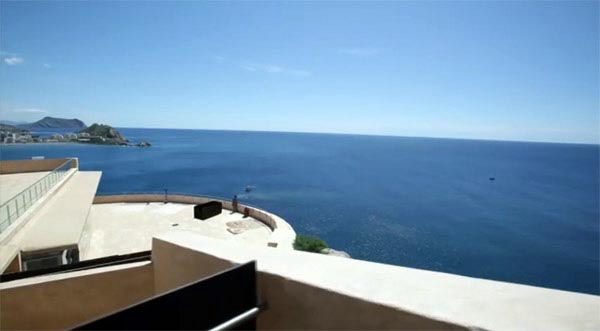
PROJECTION ROOM
We go down with the audioguide to enter the Audiovisual room This room was originally used as a warehouse of artillery. After the reconstruction of the castle, the room has been used to display an audiovisual about the City of Aguilas. This room, next to the magazine, was the safety place for the Artillery of the Fortification. It received favorable ventilation from a series of windows that still remain. The front porch was guarded by soldiers standing on guard in the battery of Saint Peter. In this spot, the visitor completes the tour, which is why an audiovisual containing the resources of historical, artistic and natural interest of the city is shown. This information aims to encourage the visitor to continue to learning about the city. The Pier of the Hornillo, the monument to the railway, the Tower of Cope, the urban mills, the Archaeological Museum, the Roman Baths, the local cuisine, the beaches, the traditions, etc. will be the star attractions.
GOVERNOR´ S ROOMS
We leave the room with the audioguide, and in the attached space to the right, we find the offices of the Governor of the Castle. They are also decorated in the style of the era. Since its construction, the fort has faced several modifications. One of them was the construction of a pavilion residence for the Governor of the Castle. This was in the northeast sector of the Battery of Saint Peter. This area was previously occupied by several artillery pieces and their embrasures. We can be certain of the use of this space through data taken from the castle´s architectural plan. The plan, which we have mentioned in previous sections of the audio guide, was put together by José Polo y Pavía, and drawn by Luís Pamise y Sembi. Their work allows us to know that these units consisted of living room, kitchen, a latrine which emptied over the cliff, and a room for a slave, as well as the corresponding bedroom.
VIEWS
To conclude the visit with the audioguide, either from the square or the walkable area of the described buildings, you can enjoy amazing views with the help of the two installed telescopes.
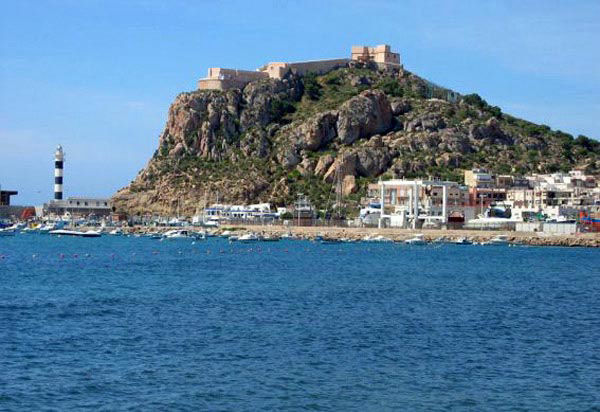
Castle of San Juan: Peña Tejada-Cerro de las Águilas 30880 Águilas, Murcia
- Tel.: +34 96 841 88 38 - cultura@ayuntamientodeaguilas.org - www.aguilas.es -
Back to Index